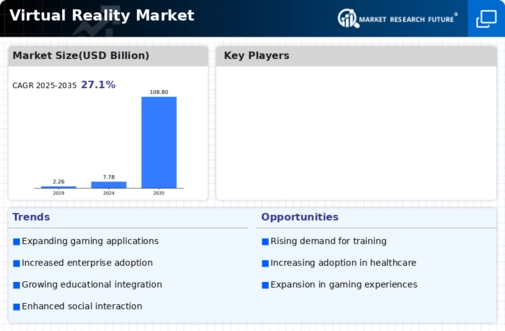Market Share
Introduction: Navigating the Competitive Landscape of Virtual Reality
The virtual reality market is being reshaped by the rapid development of the technology, the changes in consumer behavior, and the regulatory environment. The key players, including the original equipment manufacturers, IT service companies, and the equipment suppliers, are competing to lead the market by deploying the advanced technology of big data analysis and IoT to enhance the experience and efficiency of the users. The newcomers, especially the agile AI companies, are challenging the traditional models by introducing automation and biometrics to change the interaction with the users and the security of the data. The strategic deployments of the key players are now mainly focused on the virtual reality applications in the education, medical care, and entertainment industries, which can meet the demand of the local market. The next two years are critical for the key players to develop strategies based on these technological innovations and local opportunities to secure their position in the market.
Competitive Positioning
Full-Suite Integrators
These vendors provide comprehensive VR solutions, integrating hardware and software for a seamless user experience.
| Vendor | Competitive Edge | Solution Focus | Regional Focus |
|---|---|---|---|
| Sony Corporation | Strong gaming ecosystem integration | Gaming and entertainment VR solutions | Global |
| Microsoft Corporation | Enterprise-focused mixed reality solutions | Enterprise and productivity applications | Global |
| Facebook Inc | Social connectivity and community building | Social VR platforms | Global |
Specialized Technology Vendors
These companies focus on niche VR technologies, enhancing specific aspects of the VR experience.
| Vendor | Competitive Edge | Solution Focus | Regional Focus |
|---|---|---|---|
| Google LLC | Innovative software and platform development | VR software and applications | Global |
| Qualcomm Technologies Inc. | Leading mobile processing technology | Mobile VR hardware and chipsets | Global |
Infrastructure & Equipment Providers
These vendors supply the essential hardware and infrastructure needed for VR experiences.
| Vendor | Competitive Edge | Solution Focus | Regional Focus |
|---|---|---|---|
| Samsung Electronics | High-quality display technology | VR headsets and accessories | Global |
| Sensics Inc. | Customizable VR solutions for enterprises | Professional VR systems | Global |
| Vuzix Corporation | Augmented reality integration | Smart glasses and AR/VR solutions | Global |
Emerging Players & Regional Champions
- High-quality VR glasses for professional use in aviation and health care. Recently teamed up with a major training company to enhance simulations, and now compete with Oculus with its higher resolution and performance.
- XRHealth (Israel) specializes in the development of virtual reality solutions for the health sector, with a focus on rehabilitation and pain management. The company has recently installed its VR therapy platform in several hospitals, complementing the health care system by providing new, digital treatment options.
- VIVE (Taiwan): It offers a range of VR hardware and software, including the VIVE FOCUS series, and has recently stepped up its business solutions for training and collaboration, making it a strong rival to the likes of Oculus and HTC.
- Immersive Tech (Canada): Virtual reality training for construction and manufacturing companies. Recently signed contracts with several large companies to offer safety training, thereby competing with the established training industry and traditional methods.
Regional Trends: In 2023, virtual reality technology will be widely used in the fields of medicine and enterprise education. North America and Europe are the pioneers in the specialization of technology, and the focus is on high-fidelity simulation and industrial applications. The new players in the field of virtual reality are gradually emerging, and the new players in the field of virtual reality are gradually emerging, and they often complement or compete with the old players, and they often offer more specialized, more tailored and more advanced products.
Collaborations & M&A Movements
- Meta Platforms and Qualcomm announced a partnership to develop next-generation VR hardware, aiming to enhance user experience and solidify their positions in the competitive VR landscape.
- Sony Interactive Entertainment acquired the VR game studio FireSprite to bolster its PlayStation VR offerings, thereby increasing its market share in the gaming segment of the VR industry.
- NVIDIA and Unity Technologies entered into a collaboration to optimize real-time rendering for VR applications, enhancing the capabilities of developers and potentially increasing their competitive edge in the VR content creation market.
Competitive Summary Table
| Capability | Leading Players | Remarks |
|---|---|---|
| Biometric Self-Boarding | Apple, Meta | Apple has integrated biometric features in its Vision Pro headset, allowing seamless user authentication. Meta's Quest Pro utilizes facial recognition for personalized experiences, enhancing user engagement. |
| AI-Powered Ops Mgmt | NVIDIA, Unity | NVIDIA's Omniverse platform leverages AI for real-time simulations, optimizing VR environments for developers. Unity's AI tools streamline content creation, making it easier for developers to implement complex scenarios. |
| Border Control | Microsoft, IBM | Microsoft's Azure cloud services support VR applications for border control, utilizing AI to analyze data. IBM's Watson has been applied in VR simulations for training border control personnel, enhancing operational efficiency. |
| Sustainability | HTC, Sony | HTC's Vive series emphasizes eco-friendly materials and energy-efficient designs. Sony's PlayStation VR has initiatives focused on reducing carbon footprint through sustainable manufacturing practices. |
| Passenger Experience | Oculus, Samsung | Oculus offers immersive experiences tailored for entertainment and education, enhancing user satisfaction. Samsung's Gear VR has been used in various travel applications, improving passenger engagement during flights. |
Conclusion: Navigating the Competitive VR Landscape
In 2023, the virtual reality market will be characterized by intense competition and significant fragmentation, with both established and new players vying for market share. The established companies will be able to exploit their brand strength and technological expertise, while the newcomers will be able to focus on new applications and niche markets. North America will continue to lead in the market, as it has done in the past, but Asia-Pacific will be the most promising region for growth, as it is investing in the necessary virtual reality infrastructure. To gain a leadership position, the vendors must focus on the following key capabilities: integration of AI, automation, scalability, and flexibility. Strategic alliances and an understanding of regional trends will be crucial to success in the rapidly evolving market.

















Leave a Comment